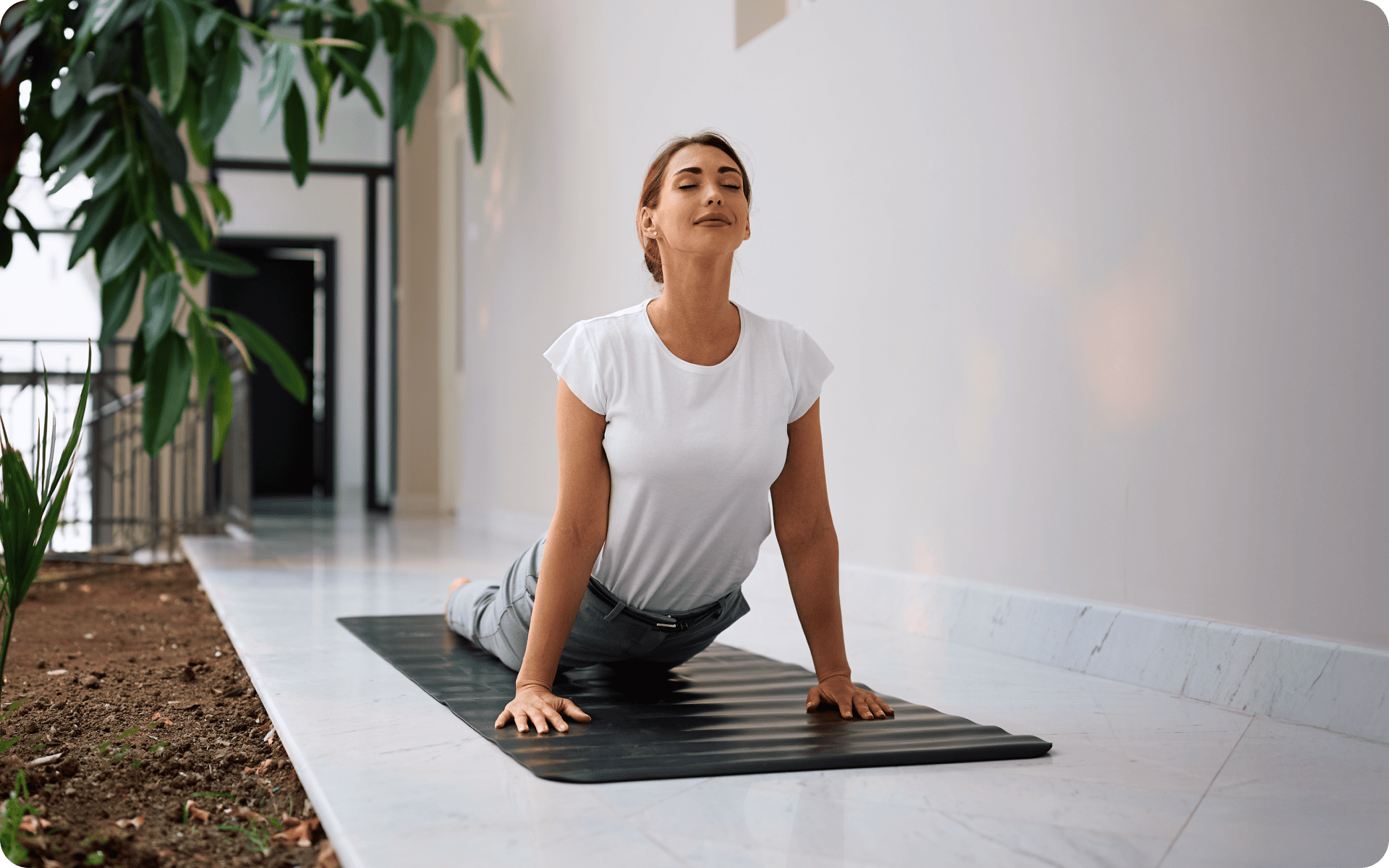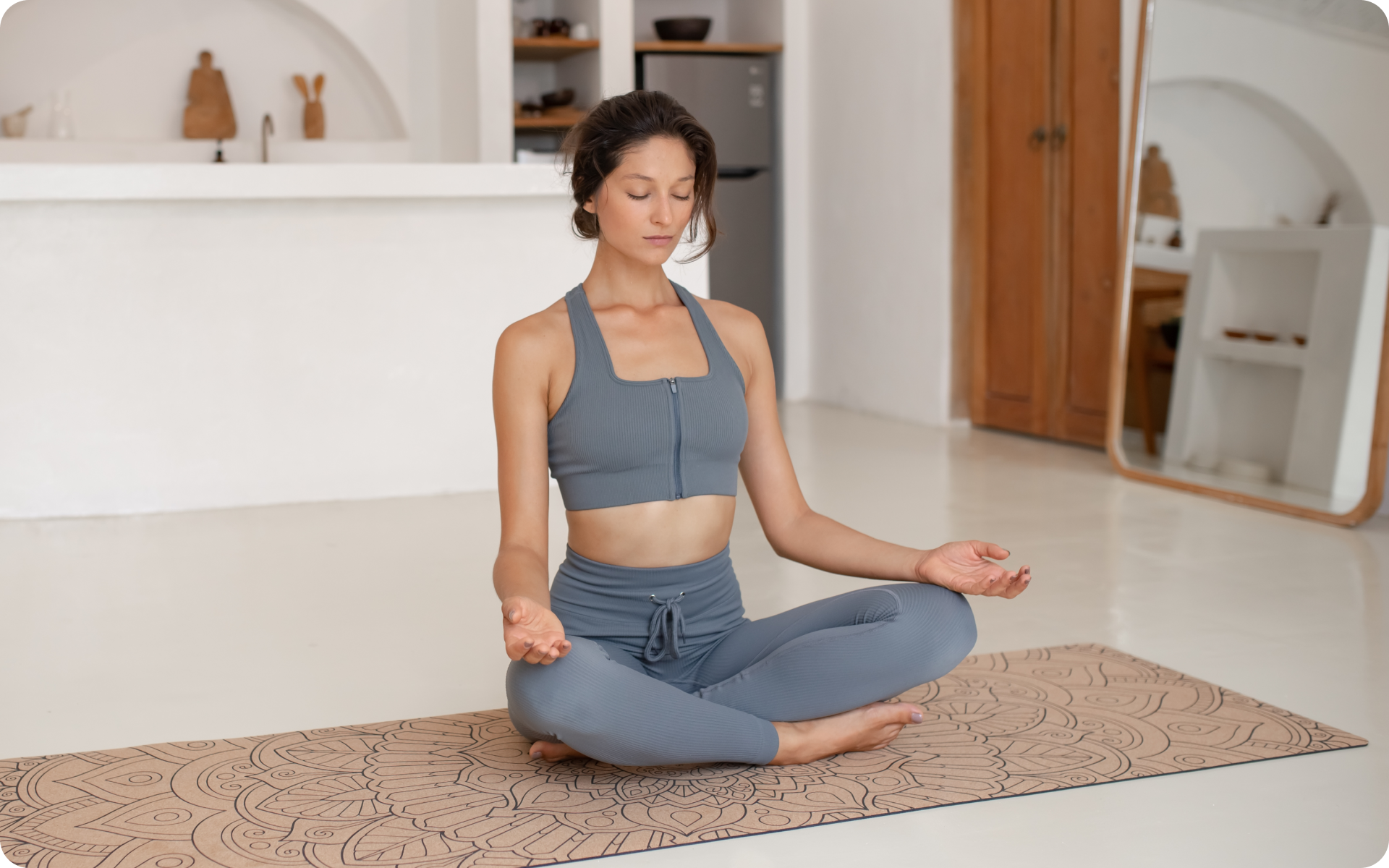Somatic exercises and yoga have a lot in common. Have you ever felt mentally and physically drained? You’re not alone. Many of us carry the weight of stress and trauma in our bodies, which leads to reflex patterns that cause chronic muscle contractions (8). Over time, these contractions become involuntary and can’t be relaxed. This weight of stress and tension in our bodies can lead to a whole slew of uncomfortable and sometimes miserable symptoms including poor posture, feeling as if we’re made of inflexible cardboard, stumbling over our own feet, dealing with persistent aches and pains, and just an overall dip in quality of life (3). It’s like our bodies are sending out an SOS, and it’s up to us to find a way to answer the call and restore that balance.
So, what exactly is happening in our bodies? Well, it’s as if there’s a constant signal being sent from the deeper parts of our brain, the subcortical brainstem, straight to our muscles, telling them to tighten up and stay that way (8). Basically, our brain’s stuck in “stress mode” and our muscles are just following orders by staying tightened. But here’s the good news: We can hit the reset button by shifting control back to the cortical part of the brain. That way, we can voluntarily tell our muscles to relax, which gives us some much-needed relief from the symptoms.
This is where somatic exercises come into play. These exercises focus on a technique called pandiculation, which involves three key steps: voluntary muscle contraction, slow and controlled decontraction (eccentric contraction), and a constant focus on sensation (3).
Here’s how it works:
– Pandiculation: Imagine a cat stretching after a nap. That’s pandiculation—a natural, instinctive movement that involves the entire body. It helps reset muscle length and function.
– Voluntary Contraction: You consciously contract your muscles, which helps bring awareness to them.
– Slow Controlled Decontraction: You then slowly release the contraction, extending the muscle with minimal effort, which helps to re-educate your nervous system and muscle fibers.
These movements are always performed gently and slowly, with the least possible effort. This mindful approach ensures that the exercises are never forced, which makes them safe and accessible for everyone. By incorporating these gentle, mindful movements, you can gradually increase the resting length of your muscles. This means your muscles will be less tense and more relaxed when at rest, leading to better posture, greater flexibility, improved balance, reduced pain, and an overall boost in your quality of life.
Of the myriad practices that are available in the modern era, somatic exercises and yoga stand out as two powerful approaches to achieving mind-body balance. While both methods offer unique benefits, understanding their differences can help you choose the best path for your wellness journey.
Is Yoga Somatic Experiencing?
Yoga and somatic experiencing are related practices, but they differ in terms of approach and focus.
Yoga is a comprehensive system that integrates physical postures (asanas), breathing techniques (pranayama), meditation (dhyana), and philosophical principles (1). Yoga is practiced worldwide for its numerous health benefits, including increased flexibility, strength, balance, and mental clarity. While yoga involves a mind-body connection and can lead to a sense of somatic awareness, its primary aim is often broader, encompassing spiritual, mental, and physical well-being.
On the other hand, somatic experiencing (SE) is a therapeutic approach that was developed by Dr. Peter Levine to address trauma and stress-related disorders (6). It focuses specifically on the body’s response to stress and trauma, aiming to release the stored emotions linked to traumatic events and restore the nervous system’s natural balance. SE involves gentle body-focused techniques and awareness exercises to help you renegotiate and heal from traumatic experiences.
While both yoga and somatic experiencing involve somatic practices and can enhance somatic awareness, their purposes and methodologies are distinct. Yoga offers a holistic approach to well-being, encompassing various styles such as Hatha Yoga, Vinyasa Yoga, Ashtanga Yoga, and Yin Yoga, each with its own focus. Hatha Yoga serves as a gentle introduction to basic postures, while Vinyasa Yoga offers a dynamic flow linking breath with movement. Ashtanga Yoga follows a rigorous style with a specific sequence of postures, and Yin Yoga provides a slow-paced practice, holding poses for longer periods to stretch connective tissues. In contrast, somatic experiencing is a targeted therapeutic modality for addressing trauma and stress.
BetterMe: Meditation & Sleep app can help you transmute stress into serenity, pull you up from the doldrums, free your mind from the cares and worries of the world, quell racing thoughts and infuse you with tranquility! Start using it now and change your life !
Somatic Yoga
For those who are looking to blend the benefits of yoga with somatic principles, Somatic Yoga offers a perfect solution. Developed by Eleanor Criswell, it is a unique approach that merges somatics (mind-body integration), Hatha Yoga, and Raja Yoga (Patanjali’s Yoga) (3). It draws from a rich tapestry of disciplines, including somatics, traditional yoga, neuroscience (especially the somatic nervous system), applied psychophysiology, and psychology (3).
Somatic Yoga emphasizes mindful movement and awareness, integrating the gentle, therapeutic aspects of somatic exercises with the holistic and spiritual dimensions of yoga. Research has shown that this approach helps alleviate physical tension and improve mobility while improving quality of life, flexibility, and balance in cancer survivors (3). It also fosters a deeper connection between mind and body, enhancing overall mental and physical well-being.
Somatic Exercises
Somatic exercises are less well-known but equally transformative. “Somatic” comes from the Greek word “soma”, which means “body”. These exercises focus on internal physical perception and experience rather than external appearance or performance. The goal is to retrain the nervous system to release chronic muscle tension and improve overall movement patterns.
Developed by pioneers like Thomas Hanna, somatic exercises are often used in therapeutic settings to address pain, improve posture, and increase mobility (10). The exercises are typically slow, gentle movements performed with focused awareness. This mindful approach helps to re-educate the brain and muscles, promoting more efficient and comfortable movement.
Both somatic exercises and somatic yoga offer transformative benefits, helping you achieve a harmonious balance between body and mind. By exploring these practices and finding the one that resonates with you, you can embark on a rewarding journey toward improved health and well-being.
What are the Benefits of Somatic Exercises and Somatic Yoga?
- Pain Management: Both somatic exercises and Somatic Yoga can help alleviate chronic pain by releasing tension and promoting relaxation in the muscles.
- Improved Mobility and Flexibility: By retraining the nervous system and improving movement patterns, both somatic exercises and Somatic Yoga can enhance flexibility and mobility. Like traditional yoga, somatic yoga can enhance flexibility, strength, and balance through mindful movement and breathwork (3).
- Stress Reduction: Somatic exercises and Somatic Yoga promote relaxation and stress relief, helping to reduce the physical and mental effects of stress on the body.
- Enhanced Body Awareness: Practicing both somatic exercises and Somatic Yoga increases awareness of body sensations, which creates a deeper mind-body connection.
- Postural Correction: Both somatic exercises and Somatic Yoga can help correct imbalances and improve posture by releasing habitual muscle tension.
- Emotional Well-being: Somatic exercises and Somatic Yoga encourage relaxation and mindfulness, which can contribute to improved emotional health and well-being.
- Mind-Body Integration: Somatic exercise and Somatic Yoga improve the mind-body connection. Somatic Yoga specifically emphasizes combining the benefits of traditional yoga with somatic principles, promoting a deeper connection between mind and body.
- Holistic Wellness: Both somatic exercises and Somatic Yoga address the whole person, promoting physical, mental, and emotional well-being through integrated movement, breath, and mindful movements.
Read more: Somatic Healing Techniques: A Holistic Approach to Physical and Emotional Recovery
Do Somatic Exercises Really Work?
Yes, somatic exercises can be highly effective for many individuals. These exercises focus on releasing chronic muscle tension, improving movement patterns, and enhancing body awareness, often resulting in reduced pain, improved flexibility, and better overall well-being (4, 7). By using techniques such as pandiculation, voluntary muscle contraction, and slow controlled decontraction, somatic exercises help retrain the nervous system and promote relaxation in the body. Many people find relief from various issues, including chronic pain, stiffness, stress-related tension, and postural imbalances, through the consistent practice of somatic exercises. However, as with any therapeutic modality, the effectiveness of somatic exercises can vary depending on individual factors such as the nature and severity of the condition, consistency of practice, and adherence to proper technique.
Is Somatic Yoga the Same As Restorative Yoga?
Somatic Yoga and Restorative Yoga are related practices, but they have distinct approaches and purposes.
Somatic Yoga blends somatics (mind-body integration), Hatha yoga, and Raja Yoga (Patanjali’s Yoga) (3). It emphasizes mindful movement, awareness, and the integration of the body and mind. Somatic Yoga typically involves gentle, therapeutic movements that aim to release tension, improve mobility, and foster a deeper connection with oneself.
Restorative Yoga is a passive form of yoga that focuses on relaxation and rejuvenation. It involves supported poses held for extended periods, often using props such as blankets, bolsters, and blocks. The goal of Restorative Yoga is to activate the body’s parasympathetic nervous system, promoting deep relaxation and stress relief (5).
While both Somatic Yoga and Restorative Yoga prioritize relaxation and mind-body connection, Somatic Yoga tends to involve more active and intentional participation and exploration of movement and its sensations, while Restorative Yoga is characterized by passive, supported poses aimed at deep relaxation.
Whether you want to learn how to exit the spiral of self-harming behavior, overcome anxiety, cure insomnia or simply give yourself the time and space to bliss out and soak up the moment of complete peace and quiet – BetterMe: Meditation & Sleep app is exactly the tool for that ! If you don’t take care of number one, who will?
Finding Your Perfect Balance
Choosing between traditional yoga, somatic exercises, or Somatic Yoga—or combining them—depends on your personal goals and preferences. Here are a few tips to help you decide:
– Assess Your Needs: Identify whether you seek to improve flexibility and strength (yoga), relieve chronic pain and tension (somatic exercises), or achieve a balanced integration of both (Somatic Yoga).
– Experiment: Try different styles of yoga, somatic exercises, and Somatic Yoga to see what resonates with you. Many studios and online platforms offer introductory classes.
– Listen to Your Body: Pay attention to how your body responds to each practice. The right choice should leave you feeling balanced, relaxed, and rejuvenated.
– Consult Professionals: If you have specific health concerns or conditions, consider consulting a professional such as a somatic therapist for personalized guidance.
FAQs
Is yoga good for somatic healing?
Traditional yoga can be incredibly helpful in increasing flexibility, strength, balance, and mental clarity. However, Somatic Yoga can cultivate greater body awareness, release tension held in the muscles, improve breathing patterns, and promote relaxation. Somatic Yoga also incorporates mindfulness and meditation techniques that can help you connect with your body on a deeper level, facilitating the processing and release of stored emotional or somatic stress (2). The combination of physical and mindful movement and breathwork in Somatic Yoga makes it a comprehensive approach to somatic healing, which offers a holistic pathway toward greater health and well-being.
What is an example of Somatic Yoga?
A typical Somatic Yoga sequence could include exercises such as pelvic tilts, spinal waves, and gentle stretches that are designed to mobilize the spine and joints while encouraging relaxation and presence in the body. Throughout the practice, emphasis is placed on breath awareness and the connection between movement and sensation, fostering a deeper mind-body connection and facilitating somatic healing.
Is Pilates a somatic practice?
Pilates incorporates elements of body awareness and mindful movement that are akin to somatic practices, but its primary aim is physical conditioning rather than somatic healing. While Pilates can enhance body awareness and control, it does not specifically target the release of stored tension or trauma resolution, as somatic practices such as somatic experiencing or Somatic Yoga do.
Is tai chi a somatic approach?
Yes, tai chi can be considered a somatic approach. Somatic exercises focus on the mind-body connection and often involve gentle, mindful movement aimed at increasing body awareness and promoting relaxation. Tai chi is an ancient Chinese martial art that emphasizes slow, flowing movements coordinated with deep breathing and mental focus. This practice can create a heightened awareness of body sensations and alignment while moving through a series of postures and transitions. This mindful movement, coupled with breath awareness, can help reduce stress, improve balance and coordination, and promote overall well-being, which aligns with the principles of somatic practices (9).
DISCLAIMER:
This article is intended for general informational purposes only and does not serve to address individual circumstances. It is not a substitute for professional advice or help and should not be relied on for making any kind of decision-making. Any action taken as a direct or indirect result of the information in this article is entirely at your own risk and is your sole responsibility.
BetterMe, its content staff, and its medical advisors accept no responsibility for inaccuracies, errors, misstatements, inconsistencies, or omissions and specifically disclaim any liability, loss or risk, personal, professional or otherwise, which may be incurred as a consequence, directly or indirectly, of the use and/or application of any content.
You should always seek the advice of your physician or other qualified health provider with any questions you may have regarding a medical condition or your specific situation. Never disregard professional medical advice or delay seeking it because of BetterMe content. If you suspect or think you may have a medical emergency, call your doctor.
SOURCES
- A Review on Yoga Therapy (2022, researchgate.net)
- Effect of 12 weeks of yoga training on the somatization, psychological symptoms, and stress-related biomarkers of healthy women (2014, ncbi.nlm.nih.gov)
- Impact of Somatic Yoga and Meditation on Fall Risk, Function, and Quality of Life for Chemotherapy-Induced Peripheral Neuropathy Syndrome in Cancer Survivors (2019, journals.sagepub.com)
- Moving With Pain: What Principles From Somatic Practices Can Offer to People Living With Chronic Pain (2020, frontiersin.org)
- Restorative yoga for occupational stress among Japanese female nurses working night shift: Randomized crossover trial (2019, academic.oup.com)
- Somatic experiencing: using interoception and proprioception as core elements of trauma therapy (2015, frontiersin.org)
- Somatic Strength Training: An Alternative to “No Pain No Gain” (2020, liebertpub.com)
- Stress effects on the body (2023, apa.org)
- Tai Chi and Qigong for the Treatment and Prevention of Mental Disorders (2014, ncbi.nlm.nih.gov)
- The body of life : creating new pathways for sensory awareness and fluid movement (1993, cir.nii.ac.jp)










